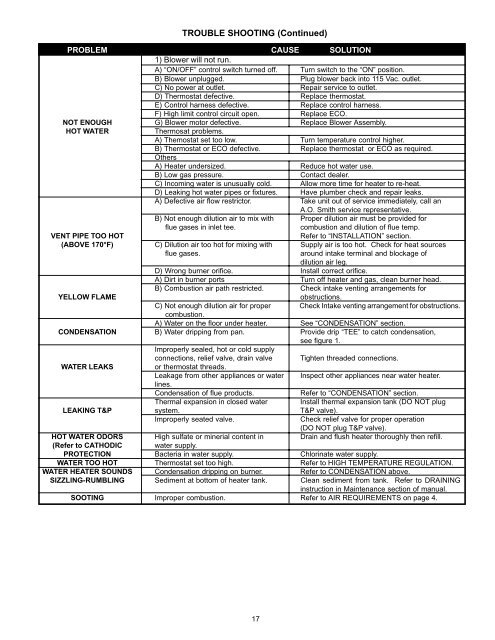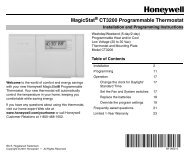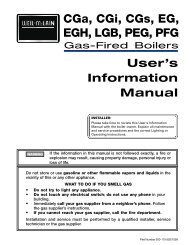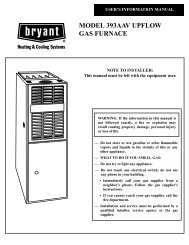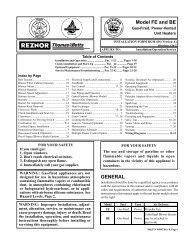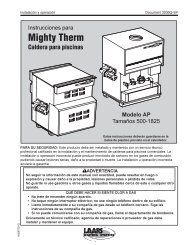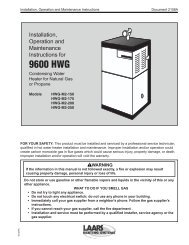Power Vented Gas Models FPSH/FPCR/FPST with ... - Geisel
Power Vented Gas Models FPSH/FPCR/FPST with ... - Geisel
Power Vented Gas Models FPSH/FPCR/FPST with ... - Geisel
Create successful ePaper yourself
Turn your PDF publications into a flip-book with our unique Google optimized e-Paper software.
TROUBLE SHOOTING (Continued)<br />
PROBLEM CAUSE SOLUTION<br />
1) Blower will not run.<br />
A) “ON/OFF” control switch turned off. Turn switch to the “ON” position.<br />
B) Blower unplugged. Plug blower back into 115 Vac. outlet.<br />
C) No power at outlet. Repair service to outlet.<br />
D) Thermostat defective. Replace thermostat.<br />
E) Control harness defective. Replace control harness.<br />
F) High limit control circuit open. Replace ECO.<br />
NOT ENOUGH G) Blower motor defective. Replace Blower Assembly.<br />
HOT WATER Thermosat problems.<br />
A) Themostat set too low. Turn temperature control higher.<br />
B) Thermostat or ECO defective. Replace thermostat or ECO as required.<br />
Others<br />
A) Heater undersized. Reduce hot water use.<br />
B) Low gas pressure. Contact dealer.<br />
C) Incoming water is unusually cold. Allow more time for heater to re-heat.<br />
D) Leaking hot water pipes or fixtures. Have plumber check and repair leaks.<br />
A) Defective air flow restrictor. Take unit out of service immediately, call an<br />
A.O. Smith service representative.<br />
B) Not enough dilution air to mix <strong>with</strong> Proper dilution air must be provided for<br />
flue gases in inlet tee. combustion and dilution of flue temp.<br />
VENT PIPE TOO HOT Refer to “INSTALLATION” section.<br />
(ABOVE 170°F) C) Dilution air too hot for mixing <strong>with</strong> Supply air is too hot. Check for heat sources<br />
flue gases. around intake terminal and blockage of<br />
dilution air leg.<br />
D) Wrong burner orifice. Install correct orifice.<br />
A) Dirt in burner ports Turn off heater and gas, clean burner head.<br />
B) Combustion air path restricted. Check intake venting arrangements for<br />
YELLOW FLAME obstructions.<br />
C) Not enough dilution air for proper Check Intake venting arrangement for obstructions.<br />
combustion.<br />
A) Water on the floor under heater. See “CONDENSATION” section.<br />
CONDENSATION B) Water dripping from pan. Provide drip “TEE” to catch condensation,<br />
see figure 1.<br />
Improperly sealed, hot or cold supply<br />
connections, relief valve, drain valve Tighten threaded connections.<br />
WATER LEAKS or thermostat threads.<br />
Leakage from other appliances or water Inspect other appliances near water heater.<br />
lines.<br />
Condensation of flue products. Refer to “CONDENSATION” section.<br />
Thermal expansion in closed water Install thermal expansion tank (DO NOT plug<br />
LEAKING T&P system. T&P valve).<br />
Improperly seated valve. Check relief valve for proper operation<br />
(DO NOT plug T&P valve).<br />
HOT WATER ODORS High sulfate or minerial content in Drain and flush heater thoroughly then refill.<br />
(Refer to CATHODIC water supply.<br />
PROTECTION Bacteria in water supply. Chlorinate water supply.<br />
WATER TOO HOT Thermostat set too high. Refer to HIGH TEMPERATURE REGULATION.<br />
WATER HEATER SOUNDS Condensation dripping on burner. Refer to CONDENSATION above.<br />
SIZZLING-RUMBLING Sediment at bottom of heater tank. Clean sediment from tank. Refer to DRAINING<br />
instruction in Maintenance section of manual.<br />
SOOTING Improper combustion. Refer to AIR REQUIREMENTS on page 4.<br />
17


